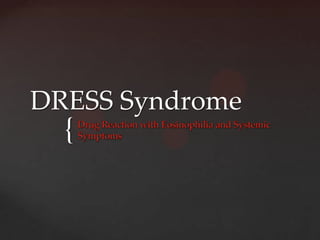
Dress syndrome
- 1. DRESS Syndrome {
- 2. Define the Adverse Drug Reactions. Understand the Etiology of Adverse Drug Reaction. Define DRESS Syndrome. Mention the Etiologic Causes. Recognize the pathophysiological mechanism Describe the Signs & Symptoms. Demonstrate the Diagnostic Investigations. Mention the Treatment options & preventive methods. Describe the prognosis OBJECTIVES
- 3. Adverse drug reaction (ADR) is a broad term referring to unwanted, uncomfortable, or dangerous effects that a drug may have. Side effect is an imprecise term often used to refer to a drug's unintended effects that occur within the therapeutic range. All drugs have the potential for ADRs. The Adverse Drug Reaction
- 4. Type A reactions are pharmacological effects that are predictable and dose- dependent and consist of side effects and drug interactions. Type B reactions are hypersensitivity reactions that are unpredictable and not dose-dependent, usually occurring at normally tolerated doses. Etiology of ADR
- 5. Drug hypersensitivity (or DRESS) is an immune-mediated reaction to a drug. Also called drug-induced hypersensitivity syndrome (DHS). DRESS Syndrome
- 6. Defect in the way the liver metabolizes drugs Co-infection with the human herpes virus 6 (HHV6) Genetic predisposition to drug hypersensitivity syndrome Etiology
- 7. Anti-gout drug { Allopurinol The most common drugs to cause this reaction Anti-epilepsy drugs (esp. carbamazepine, phenobarbital and phenytoin) sulphonamide group of antibiotics. Causative Drugs
- 8. 1. Introduction 2. Protein and large 3. Most drugs of drugs polypeptide drugs act as haptens Carrier Pathophysiology
- 9. 3. Most drugs 4. Bind to 2. Protein and large polypeptide drugs peptides in act as haptens (MHC) molecules Carrier α1 β Carrier α3 Pathophysiology α2
- 10. 4. Bind to 5. Immunogenic peptides in protein stimulate (MHC) molecules one or both of Antidrug Some drugs directly antibody stimulate production T-cell α1 β responses Carrier α3 α2 A. cytokine Pathophysiology B. Cytotoxicity
- 11. 6. Recognition to A. Releasing drug protein on Inflammation the MHC I or II cytokines CD4 CD8 Tissue injury Normal cellular tissue MHC I Neutrophil enzymes, ROS Drug carrier Neutrophil Cytokines Macrophage
- 12. 6. Recognition to B. drug protein on ONLY MHC I Cytotoxicity Cell lysis & tissue injury MHC I Drug carrier CD8+ CTLs
- 13. Symptoms and signs vary from mild to severe depending on the patient and drug Start up to 12 weeks after initiation of drug treatment and can occur after a dose increase. Symptoms may persist or recur for several weeks after stopping drug treatment. Signs and Symptoms
- 14. Prominent Hepatitis Exanthema eosinophilia Facial swelling Generalized edema Lymphadenopathy Signs and Symptoms
- 15. Patient's report of a reaction soon after taking a drug Effects of a drug, and results of a Time of onset repeat drug challenge Sometimes drug provocation testing Drug is given in escalating doses to Is usually safe and effective precipitate the reaction Sometimes direct and indirect antiglobulin assays For hematologic drug reactions Diagnosis
- 16. Drug discontinuation •stopping the implicated drug • most symptoms & signs clear in a few days Supportive treatment •antihistamines •corticosteroids •epinephrine Sometimes desensitization •if sensitivity established •if treatment is essential and no alternative •reduces sensitivity only temporarily Treatment
- 17. Avoiding the drug Carry identification or an alert bracelet. Prevention Charts should be marked.
- 18. Hypersensitivity decreases with time. The mortality from drug hypersensitivity syndrome is estimated at around 8%. Prognosis
- 19. The Merck Manual 9th E. Abbas & Lichtman, Basic Immunology 3E. http://www.dermnetnz.org/reaction s/drug-hypersensitivity- syndrome.html References
- 20. { THANKS
